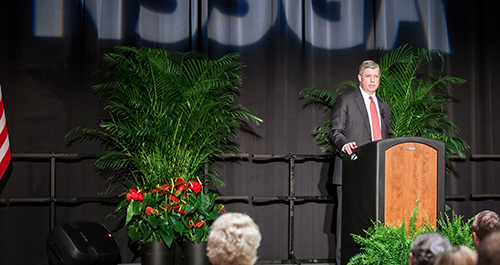Martin Marietta Materials CEO Ward Nye, chairman of NSSGA‘s board of directors, met Sept. 11 with MSHA‘s Joe Main on behalf of the association. MSHA’s Patricia Silvey, deputy assistant for policy, and Marv Lichtenfels, acting administrator for metal/non-metal, accompanied Main. NSSGA President and CEO Mike Johnson and Vice President for Safety Services Joseph Casper accompanied Nye.
According to NSSGA, Nye stated that NSSGA remains committed to working reasonably and constructively with MSHA. Nye, however, also stated that some NSSGA members are expressing concerns that the association is at times too close to MSHA. Nye further said that assuring an open and engaged, but candid, relationship between the association and MSHA is in everyone’s best interests.
Nye also reportedly told MSHA that the industry appreciates its work on inspector consistency but that it seeks more consistency. He brought up the notion of a transparent metric to illustrate progress on consistency, suggesting that the agency could periodically update operators and inspectors when citations are modified or vacated.
In response, Main said he’s seen improvements in consistency and that, in fact, fewer citations have been written this year than last year. Main also said he encourages operators to talk with their inspectors.
Another topic discussed was MSHA’s State Grants Program. Nye stressed that the $10 million training investment called for in the 1977 Mine Act is critical for safety. Main agreed that the State Grants Program is important because, despite the primacy of enforcement, compliance assistance needs to play a crucial supplemental role. He also said that his study of the situation that aggregates stakeholders received less than a proportionate amount of state grant money and that some medium-sized companies benefited to the detriment of smaller operators.
After indicating that a continuing resolution will likely fund the federal government in coming months, Main said that he has been informing state aggregates associations that his office wants collaboration with recipients of state grant money. He believes collaboration will optimize the positive impact of compliance assistance money and conceded that different state grantees deliver various levels of valuable compliance assistance.
Main also said he wants to re-tool education and training, as well as find a better model for delivery. Johnson volunteered NSSGA to help in that effort.
Later, Nye made the case for MSHA to focus on facilities failing to demonstrate due respect for compliance and safety. Nye said inspectors should direct their effort toward poorer-performing facilities.
According to NSSGA, Main responded with mention of mandatory two inspections for surface facilities and four inspections for underground facilities. Main also said he would welcome information, context and data NSSGA might be able to provide.
NSSGA says it will fashion protocols by which MSHA could establish the criteria necessary for delineating outstanding facilities and companies worthy of benefitting with a pilot pattern of compliance program.
NSSGA and MSHA also discussed how inspectors typically spend their time at high-performing operations. Nye said the association believes inspectors should use their time at mines as an opportunity to more positively interact with miners, promote safety and encourage adoption of best practices. Lichtenfels replied that while the agency already encourages this interaction, it would do more to promote the practice.
Photo: Martin Marietta Materials











